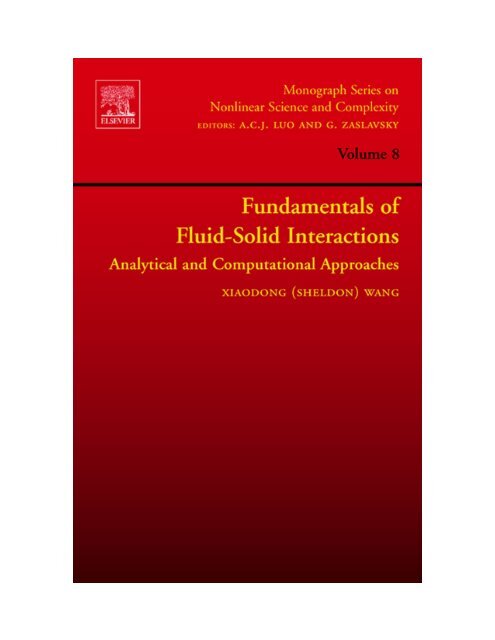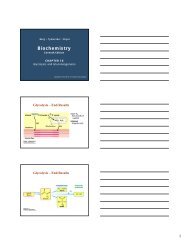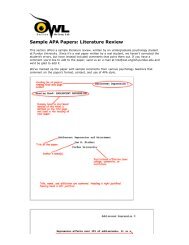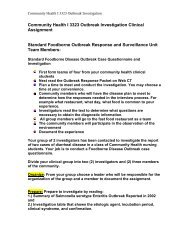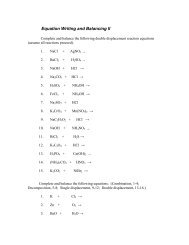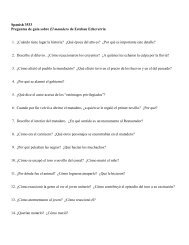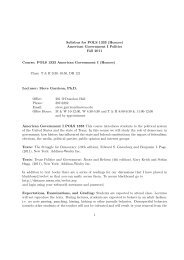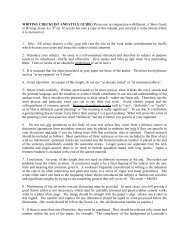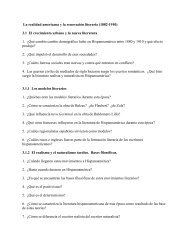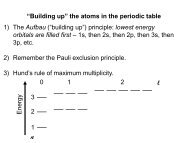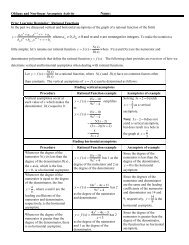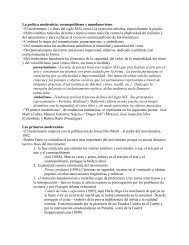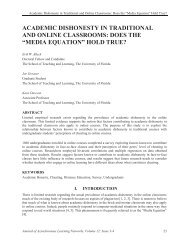Fundamentals of Fluid-Solid Interactions-Analytical and
Fundamentals of Fluid-Solid Interactions-Analytical and
Fundamentals of Fluid-Solid Interactions-Analytical and
You also want an ePaper? Increase the reach of your titles
YUMPU automatically turns print PDFs into web optimized ePapers that Google loves.
<strong>Fundamentals</strong> <strong>of</strong> <strong>Fluid</strong>–<strong>Solid</strong><br />
<strong>Interactions</strong><br />
<strong>Analytical</strong> <strong>and</strong> Computational Approaches
MONOGRAPH SERIES ON NONLINEAR<br />
SCIENCE AND COMPLEXITY<br />
SERIES EDITORS<br />
Albert C.J. Luo<br />
Southern Illinois University, Edwardsville, USA<br />
George Zaslavsky<br />
New York University, New York, USA<br />
ADVISORY BOARD<br />
Valentin Afraimovich, San Luis Potosi University, San Luis Potosi, Mexico<br />
Maurice Courbage, Université Paris 7, Paris, France<br />
Ben-Jacob Eshel, School <strong>of</strong> Physics <strong>and</strong> Astronomy, Tel Aviv University,<br />
Tel Aviv, Israel<br />
Bernold Fiedler, Freie Universität Berlin, Berlin, Germany<br />
James A. Glazier, Indiana University, Bloomington, USA<br />
Nail Ibragimov, IHN, Blekinge Institute <strong>of</strong> Technology, Karlskrona, Sweden<br />
Anatoly Neishtadt, Space Research Institute Russian Academy <strong>of</strong> Sciences,<br />
Moscow, Russia<br />
Leonid Shilnikov, Research Institute for Applied Mathematics & Cybernetics,<br />
Nizhny Novgorod, Russia<br />
Michael Shlesinger, Office <strong>of</strong> Naval Research, Arlington, USA<br />
Dietrich Stauffer, University <strong>of</strong> Cologne, Köln, Germany<br />
Jian-Qiao Sun, University <strong>of</strong> Delaware, Newark, USA<br />
Dimitry Treschev, Moscow State University, Moscow, Russia<br />
Vladimir V. Uchaikin, Ulyanovsk State University, Ulyanovsk, Russia<br />
Angelo Vulpiani, University La Sapienza, Roma, Italy<br />
Pei Yu, The University <strong>of</strong> Western Ontario, London, Ontario N6A 5B7, Canada
<strong>Fundamentals</strong> <strong>of</strong> <strong>Fluid</strong>–<strong>Solid</strong><br />
<strong>Interactions</strong><br />
<strong>Analytical</strong> <strong>and</strong> Computational Approaches<br />
XIAODONG (SHELDON) WANG<br />
Department <strong>of</strong> Mathematical Sciences<br />
New Jersey Institute <strong>of</strong> Technology<br />
323 Martin Luther King, Jr. Blvd.<br />
Newark, NJ 07102, USA<br />
AMSTERDAM • BOSTON • HEIDELBERG • LONDON • NEW YORK • OXFORD<br />
PARIS • SAN DIEGO • SAN FRANCISCO • SINGAPORE • SYDNEY • TOKYO
Elsevier<br />
Radarweg 29, PO Box 211, 1000 AE Amsterdam, The Netherl<strong>and</strong>s<br />
Linacre House, Jordan Hill, Oxford OX2 8DP, UK<br />
First edition 2008<br />
Copyright © 2008 Elsevier B.V. All rights reserved<br />
No part <strong>of</strong> this publication may be reproduced, stored in a retrieval system or transmitted in any form<br />
or by any means electronic, mechanical, photocopying, recording or otherwise without the prior written<br />
permission <strong>of</strong> the publisher<br />
Permissions may be sought directly from Elsevier’s Science & Technology Rights Department in Oxford,<br />
UK: phone (+44) (0) 1865 843830; fax (+44) (0) 1865 853333; email: permissions@elsevier.com. Alternatively<br />
you can submit your request online by visiting the Elsevier web site at http://www.elsevier.com/<br />
locate/permissions, <strong>and</strong> selecting Obtaining permission to use Elsevier material<br />
Notice<br />
No responsibility is assumed by the publisher for any injury <strong>and</strong>/or damage to persons or property as<br />
a matter <strong>of</strong> products liability, negligence or otherwise, or from any use or operation <strong>of</strong> any methods,<br />
products, instructions or ideas contained in the material herein. Because <strong>of</strong> rapid advances in the medical<br />
sciences, in particular, independent verification <strong>of</strong> diagnoses <strong>and</strong> drug dosages should be made<br />
Library <strong>of</strong> Congress Cataloging-in-Publication Data<br />
A catalog record for this book is available from the Library <strong>of</strong> Congress<br />
British Library Cataloguing in Publication Data<br />
A catalogue record for this book is available from the British Library<br />
ISBN: 978-0-444-52807-0<br />
ISSN: 1574-6917<br />
For information on all Elsevier publications<br />
visit our website at elsevierdirect.com<br />
Printed <strong>and</strong> bound in Hungary<br />
08 09 10 11 12 10 9 8 7 6 5 4 3 2 1
Contents<br />
Preface vii<br />
Chapter 1. Introduction 1<br />
1.1. Historical background 1<br />
1.2. Motivation 3<br />
1.3. Outline 4<br />
Chapter 2. Aspects <strong>of</strong> Mathematics <strong>and</strong> Mechanics 5<br />
2.1. Preliminary concepts <strong>and</strong> notations 5<br />
2.1.1 Logic; set, group, <strong>and</strong> field; Boolean algebra 5<br />
2.1.2 Mapping <strong>and</strong> linear space; grad, div, <strong>and</strong> curl 9<br />
2.1.3 Tensors <strong>and</strong> curvilinear coordinates; complex variables 15<br />
2.1.4 Eigenvalues <strong>and</strong> eigenvectors; singular value decomposition 25<br />
2.2. Kinematical descriptions <strong>and</strong> conservation laws 31<br />
2.2.1 Mass point <strong>and</strong> rigid body; continuum 32<br />
2.2.2 Vector calculus; transport theorems <strong>and</strong> conservation laws;<br />
variational principles 37<br />
2.3. Some mathematical tools 52<br />
2.3.1 Fourier series <strong>and</strong> transform; Laplace transform 52<br />
2.3.2 Contour integral; conformal mapping 58<br />
2.3.3 Sturm–Liouville problems; Frobenius’ methods <strong>and</strong> special<br />
functions 71<br />
Chapter 3. Dynamical Systems 85<br />
3.1. Single- <strong>and</strong> multi-degree <strong>of</strong> freedom systems 86<br />
3.1.1 Basic concepts; limit sets 86<br />
3.1.2 Bifurcations; Lagrangian dynamics 100<br />
3.1.3 Van der Pol; perturbation method; Duffing 112<br />
3.2. Lyapunov–Schmidt method 126<br />
3.2.1 Floquet theory 129<br />
3.2.2 Critical time step 133<br />
3.2.3 Mathieu–Hill system 136<br />
xi
xii Contents<br />
3.3. Basin <strong>of</strong> attractions <strong>and</strong> control <strong>of</strong> chaos 142<br />
3.3.1 Lyapunov methods 142<br />
3.3.2 Robust control; sliding mode; adaptive control; FIV model 147<br />
Chapter 4. Flow-Induced Vibrations 163<br />
4.1. Attenuator <strong>and</strong> flutter suppression 163<br />
4.1.1 Helmholtz resonator; attenuator design 164<br />
4.1.2 Reynolds equations; spatial <strong>and</strong> temporal discretizations;<br />
suppression results 169<br />
4.2. Stability issues <strong>of</strong> axial flow models 183<br />
4.2.1 Internal flow; concentric flow 183<br />
4.2.2 Buckling <strong>and</strong> flutter; parametric instability <strong>and</strong> Bolotin method 194<br />
4.2.3 Collapsible tube; tube law; transverse <strong>and</strong> axial oscillations 214<br />
4.3. Dynamics <strong>of</strong> thin structures 229<br />
4.3.1 Stationary <strong>and</strong> moving panel; MITC elements 230<br />
4.3.2 Bending <strong>and</strong> torsion; aeroelasticity models 244<br />
Chapter 5. Boundary Integral Approaches 267<br />
5.1. Underlying physics <strong>and</strong> formulations 267<br />
5.1.1 Potential flow 267<br />
5.1.2 Acoustic medium 273<br />
5.1.3 Stokes flow 274<br />
5.2. Green’s functions <strong>and</strong> boundary integrals 275<br />
5.2.1 Reciprocal relations 275<br />
5.2.2 Boundary element approaches 277<br />
5.3. FSI systems with potential flows 279<br />
5.3.1 Interaction with rigid body; added mass; lift surface 279<br />
5.3.2 Radiation <strong>and</strong> scattering 299<br />
5.3.3 Rigid body surface waves interactions 305<br />
Chapter 6. Computational Linear Models 313<br />
6.1. Potential <strong>and</strong> displacement-based formulations 313<br />
6.1.1 φ-u <strong>and</strong> p-φ-u formulations 314<br />
6.1.2 u/p <strong>and</strong> u-p-Λ formulations 321<br />
6.1.3 Solvability <strong>and</strong> stability; FSI interfaces; zero modes 328<br />
6.2. Solution procedures <strong>and</strong> convergence issues 344<br />
6.2.1 Mode superposition; direct integration methods 347<br />
6.2.2 Acoustoelastic/slosh FSI systems 356<br />
6.2.3 Inf-Sup conditions <strong>of</strong> mixed formulations 386
Contents xiii<br />
Chapter 7. Computational Nonlinear Models 407<br />
7.1. Upwind <strong>and</strong> stabilization 407<br />
7.1.1 One-dimensional model 408<br />
7.1.2 Multi-dimensional model 411<br />
7.2. Nonlinear finite element formulations for FSI systems 427<br />
7.2.1 Mixed formulations for fluid <strong>and</strong> solid domains 427<br />
7.2.2 Direct method with Jacobian matrix 436<br />
7.2.3 Matrix-free Newton–Krylov; multigrid 441<br />
7.2.4 Laminar <strong>and</strong> turbulent flows; porous interface; benchmark tests 455<br />
7.3. Immersed methods 487<br />
7.3.1 Immersed boundary method; nodal forces; incompressible<br />
continuum 489<br />
7.3.2 Particulate flow <strong>and</strong> blood modeling; mapping <strong>and</strong> kernel 499<br />
7.3.3 Fictitious domain method; immersed continuum method 527<br />
7.3.4 Implicit/compressible solver; FSI systems with immersed<br />
solids 537<br />
References 547<br />
Subject Index 567


